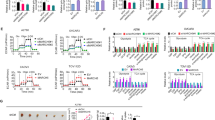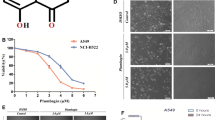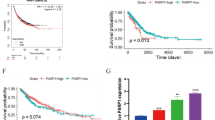Abstract
Purpose
Pyruvate kinase isoenzyme M2 (PKM2) is a key enzyme in aerobic glycolysis; inhibition of PKM2 leads to the tumor growth inhibition. In this study, the effects of combined treatment with cisplatin (DDP) and a plasmid that expresses a short hairpin RNA (shRNA) targeting PKM2 on the growth of human A549 xenograft lung cancer model were investigated.
Methods
The expression of PKM2 in A549 cells was determined by immunofluorescence. PKM2 expression levels were evaluated by Western blot analysis. In a human A549 lung cancer xenograft model, the effects of treatment with shRNA, with or without cisplatin, on tumor volume were determined. Apoptosis and cell proliferation status were examined to determine the mechanisms of tumor growth inhibition.
Results
Expression of shRNA targeting PKM2 resulted in inhibition of PKM2 expression in A549 cells. In the lung cancer xenograft model, average tumor volume in the group treated with both cisplatin and shRNA was statistically lower than those of other groups (P < 0.05). The levels of apoptotic cells were significantly higher in samples from animals in the combined treatment group than those from untreated animals (P < 0.05). The cell proliferation rate, as determined by counting cells labeled with an anti-phospho-histone H3, a marker for mitosis, was lower in samples from animals treated with both cisplatin and shRNA than in samples from other groups (P < 0.05).
Conclusions
Use of RNA interfering (RNAi) targeting PKM2 significantly inhibited tumor growth when combined with cisplatin in a human A549 lung cancer xenograft model. The enhanced antitumor activity of the combined treatment compared to treatment with shRNA alone may result in part from increased induction of apoptosis and augmented inhibition of cancer cell proliferation.





Similar content being viewed by others
References
Ahmedin J, Siegel R, Ward E, Hao Y, Xu J, Murray T, Thun MJ (2008) Cancer statistics, 2008. CA Cancer J Clin 58:71–96. doi:10.3322/CA.2007.0010
Altenberg B, Greulich KO (2004) Genes of glycolysis are ubiquitously overexpressed in 24 cancer classes. Genomics 84(6):1014–1020. doi:10.1016/j.ygeno.2004.08.010
Attila S, Veress R, Ovádi J, Csermely P, Kéri G, Ullrich A (2007) Nuclear translocation of the tumor marker pyruvate kinase M2 induces programmed cell death. Cancer Res 67(4):1602–1608. doi:10.1158/0008-5472.CAN-06-2870
Baehner R, Weidner N (2000) Enhanced mitotic figure counting in breast carcinomas using a mitosis-specific antibody: anti-phosphohistone-H3 (PHH3) [abstract]. Mod Pathol 13:17A
Christofk HR, Vander Heiden MG, Harris MH, Ramanathan A, Gerszten RE, Wei R, Fleming MD, Schreiber SL, Cantley LC (2008) The M2 splice isoform of pyruvate kinase is important for cancer metabolism and tumour growth. Nature 452(7184):230–233. doi:10.1038/nature06734
Colman H, Giannini C, Huang L, Gonzalez J, Hess K, Bruner J, Fuller G, Langford L, Pelloski C, Aaron J, Burger P, Aldape K (2006) Assessment and prognostic significance of mitotic index using the mitosis marker phospho-histone H3 in low and intermediate-grade infiltrating astrocytomas. Am J Surg Pathol 30:657–664. doi:10.1097/01.pas.0000202048.28203.25
Dastoor Z, Dreyer JL (2001) Potential role of nuclear translocation of glyceraldehyde-3-phosphate dehydrogenase in apoptosis and oxidative stress. J Cell Sci 114:1643–1653
Frank CD, Boffa DJ, Tanoue LT (2009) The new lung cancer staging system. Chest 136:260–271. doi:10.1378/chest.08-0978
Gregory M, Savaraj N, Priebe W, Braunschweiger P, Hamilton K, Tidmarsh GF, De Young LR, Lampidis TJ (2004) 2-Deoxy-d-glucose increases the efficacy of adriamycin and paclitaxel in human osteosarcoma and non-small cell lung cancers in vivo. Cancer Res 64:31–34
Gurley LR, D’Anna JA, Barham SS, Deaven LL, Tobey RA (1978) Histone phosphorylation and chromatin structure during mitosis in Chinese hamster cells. Eur J Biochem 84:1–15. doi:10.1111/j.1432-1033.1978.00001.pp.x
Hendzel MJ, Wei Y, Mancini MA, Van Hooser A, Ranalli T, Brinkley BR, Bazett-Jones DP, Allis CD (1997) Mitosis-specific phosphorylation of histone H3 initiates primarily within pericentromeric heterochromatin during G2 and spreads in an ordered fashion coincident with mitotic chromosome condensation. Chromosoma 106:348–360. doi:10.1007/s004120050256
Hendzel MJ, Nishioka WK, Raymond Y, Allis CD, Bazett-Jones DP, Th’ng JPH (1998) Chromatin condensation is not associated with apoptosis. J Biol Chem 18:24470–24478
Hu YP, Moraes C, Savaraj N, Priebe W, Lampidis TJ (2000) Rho (0) Tumor cells: a model for studying whether mitochondria are targets for rhodamine 123, doxorubicin and other drugs. Biochem Pharmacol 60(12):1897–1905. doi:10.1016/S0006-2952(00)00513-X
Hulleman E, Kazemier KM, Holleman A, VanderWeele DJ, Rudin CM, Broekhuis MJ, Evans WE, Pieters R, Den Boer ML (2009) Inhibition of glycolysis modulates prednisolone resistance in acute lymphoblastic leukemia cells. Blood 113(9):2014–2021
Khuri FR, Herbst RS, Fossella FV (2001) Emerging therapies in non-small-cell lung cancer. Ann Oncol 12:739–744
Lieberthal W, Menza SA, Levine JS (1998) Graded ATP depletion can cause necrosis or apoptosis of cultured mouse proximal tubular cells. Am J Physiol Renal Physiol 274:315–327
Lin X, Chen X, Wei Y, Zhao J, Fan L, Wen Y, Wu H, Zhao X (2007) Efficient inhibition of intraperitoneal human ovarian cancer growth and prolonged survival by gene transfer of vesicular stomatitis virus matrix protein in nude mice. Gynecol Oncol 104:540–546. doi:10.1016/j.ygyno.2006.09.022
Liu H, Hu YP, Savaraj N, Priebe W, Lampidis TJ (2001) Hypersensitization of tumor cells to glycolytic inhibitors. Biochemistry 40:5542–5547. doi:10.1021/bi002426w
Liu H, Savaraj N, Priebe W, Lampidis TJ (2002) Hypoxia increases tumor cell sensitivity to glycolytic inhibitors: a strategy for solid tumor therapy (Model C). Biochem Pharmacol 64:1746–1751. doi:10.1016/S0006-2952(02)01456-9
Loar P, Wahl H, Kshirsagar M, Gossner G, Griffith K, Liu JR (2010) Inhibition of glycolysis enhances cisplatin-induced apoptosis in ovarian cancer cells. Am J Obstet Gynecol (in press)
Majumder PK, Febbo PG, Bikoff R, Berger R, Xue Q, McMahon LM, Manola J, Brugarolas J, McDonnell TJ, Golub TR, Loda M, Lane HA, Sellers WR (2004) mTOR inhibition reverses Akt-dependent prostate intraepithelial neoplasia through regulation of apoptotic and HIF-1-dependent pathways. Nat Med 10(6):594–601. doi:10.1038/nm1052
Mazurek S, Boschek CB, Hugo F, Eigenbrodt E (2005) Pyruvate kinase type M2 and its role in tumor growth and spreading. Semin Cancer Biol 15(4):300–308. doi:10.1016/j.semcancer.2005.04.009
Nicotera P, Leist M (1997) Energy supply and the shape of death in neurons and lymphoid cells. Cell Death Differ 4:435–442
Peng XC, Yang L, Yang LP, Mao YQ, Yang HS, Liu JY, Zhang DM, Chen LJ, Wei YQ (2008) Efficient inhibition of murine breast cancer growth and metastasis by gene transferred mouse survivin Thr34 → Ala mutant. J Exp Clin Cancer Res 27:46. doi:10.1186/1756-9966-27-46
Ronai Z (1993) Glycolytic enzymes as DNA binding proteins. Int J Biochem 25:1073–1076
Sawa A, Khan AA, Hester LD, Snyder SH (1997) Glyceraldehyde-3- phosphate dehydrogenase: nuclear translocation participates in neuronal and nonneuronal cell death. Proc Natl Acad Sci USA 94:11669–11674
Shibata K, Ajiro K (1993) Cell cycle-dependent suppressive effect of histone H1 on mitosis-specific H3 phosphorylation. J Biol Chem 268:18431–18434
Spoden GA, Mazurek S, Morandell D, Bacher N, Ausserlechner MJ, Jansen-Dürr P, Eigenbrodt E, Zwerschke W (2008) Isotype-specific inhibitors of the glycolytic key regulator pyruvate kinase subtype M2 moderately decelerate tumor cell proliferation. Int J Cancer 123(2):312–321. doi:10.1002/ijc.23512
Tapia C, Kutzner H, Mentzel T, Savic S, Baumhoer D, Glatz K (2006) Two mitosis-specific antibodies, MPM-2 and phospho-histone H3 (Ser28), allow rapid and precise determination of mitotic activity. Am J Surg Pathol 30:83–89
Tarze A, Deniaud A, Le Bras M, Maillier E, Molle D, Larochette N, Zamzami N, Jan G, Kroemer G, Brenner C (2007) GAPDH, a novel regulator of the pro-apoptotic mitochondrial membrane permeabilization. Oncogene 26:2606–2620. doi:10.1038/sj.onc.1210074
The International Adjuvant Lung Cancer Trial Collaborative Group (2004) DDP-based adjuvant chemotherapy in patients with Completely resected non-small-cell lung cancer. N Engl J Med 350:351–360
Tsujimoto Y (1997) Apoptosis and necrosis: intracellular ATP level as a determinant for cell death modes. Cell Death Differ 4:429–434
Vander Heiden MG, Christofk HR, Schuman E, Subtelny AO, Sharfi H, Harlow EE, Xian J, Cantley LC (2010) Identification of small molecule inhibitors of pyruvate kinase M2. Biochem Pharmacol 79(8):1118–1124
Warburg O (1956) On the origin of cancer cells. Science 123:309–314. doi:10.1126/science.123.3191.309
Acknowledgments
This work was granted by National Basic Research Program of China (No. 2007CB947802) and National Natural Science Foundation of China (NSFC No. 30870734) and supported by the State Key Laboratory of Biotherapy and Cancer Center, Laboratory of stem cell biology, West China Hospital, West China Medical School, Sichuan University.
Conflict of interest statement
The authors declare that they have no competing interests.
Author information
Authors and Affiliations
Corresponding author
Rights and permissions
About this article
Cite this article
Guo, W., Zhang, Y., Chen, T. et al. Efficacy of RNAi targeting of pyruvate kinase M2 combined with cisplatin in a lung cancer model. J Cancer Res Clin Oncol 137, 65–72 (2011). https://doi.org/10.1007/s00432-010-0860-5
Received:
Accepted:
Published:
Issue Date:
DOI: https://doi.org/10.1007/s00432-010-0860-5




